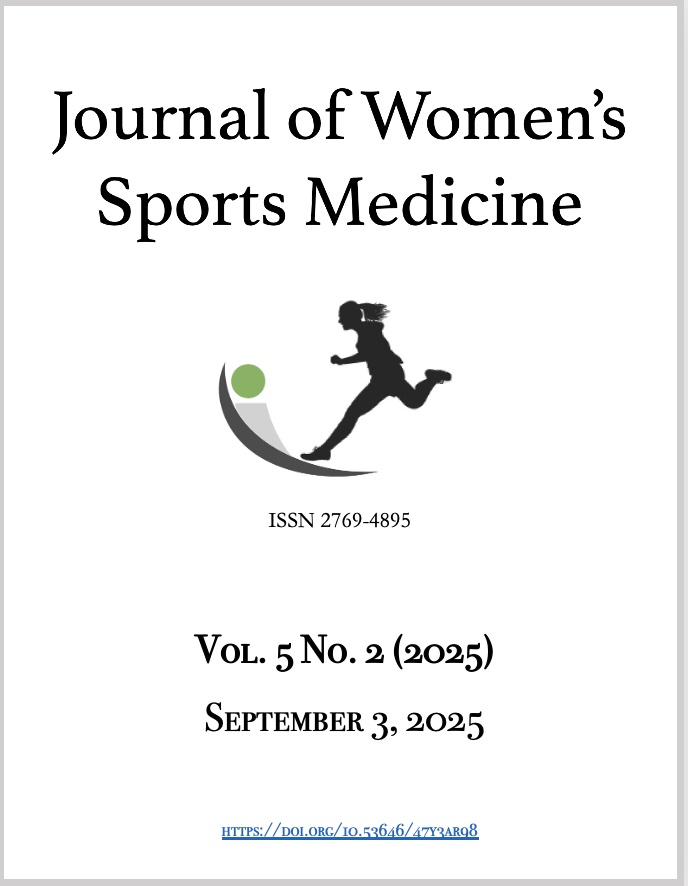Case Study: Psychoneuroendocrinology of Mild Traumatic Brain Injury Recovery
DOI:
https://doi.org/10.53646/a5xyvz06Keywords:
Psychoneuroendocrinology, mTBI recovery , sports psychologyAbstract
BACKGROUND: The correlation between the endocrine system and cognitive functioning has been increasingly discussed in the literature in recent years, as a growing number of studies in this field emerge. Despite this growth in interest in this correlation, however, the topic still remains heavily under-explored especially in the case of female athletes who have sustained traumatic brain injuries. There exist many obstacles in acquiring relevant data to enrich this field of research, including, but not limited to, current medical approaches, difficulty in isolating neurological and psychological symptoms stemming from mild traumatic brain injury (mTBI), the dismissal of multidisciplinary and holistic approaches, as well as limited resources such as time and funding. Although interest has increased and been popularized in the last decade, limited research has been conducted and/or published to specifically explore, clarify, and connect mTBI recovery with endocrine (dys)function.
METHODS: The current case study contributes to this topic and offers empirical data gathered through work with an mTBI participant with preexisting hormonal dysfunction. It describes the hormonal changes that precede and follow mTBI recovery in a female athlete, as well as her atypical recovery and long-term post-concussion symptoms. Data gathered includes hormonal charts, neurocognitive assessments, and quantitative electroencephalography (qEEG) assessments administered over a period of six years.
RESULTS: Possible interaction of the hormonal changes and their importance in mTBI recovery are theorized in this study, as well as the possible impact that mTBI can have on endocrine functioning.
CONCLUSION: The current report suggests a need for further research in the area of hormone function in females who have sustained a traumatic brain injury, even if mild in nature. On a case-by-case basis, there is clinical validity in assessing women who fail to recover from concussion in a timely manner via comprehensive hormonal evaluation and treatment combined with psychological, nutritional, and exercise interventions.
References
1. Public Health Agency of Canada. Concussion in sport [Internet]. Ottawa: Public Health Agency of Canada; 2018 Jun 7 [cited 2025 Aug 13]. https://www.canada.ca/en/public-health/services/diseases/concussion-sign-symptoms/concussion-sport-infographic.html
2. Canadian Institute for Health Information. Canadian Institute for Health Information (CIHI). CIHI. Published 1996. Updated 2025. Accessed 2025 Aug 13. https://www.cihi.ca/en
3. Public Health Agency of Canada. Traumatic brain injuries—Health Infobase [Internet]. Ottawa: Public Health Agency of Canada; 2024 [cited 2025 Aug 13]. https://health-infobase.canada.ca/brain-injuries/
4. Musko PA, Demetriades AK. Are sex differences in collegiate and high school sports-related concussion reflected in the guidelines? A scoping review. Brain Sci. 2023;13(9):1310. doi:10.3390/brainsci13091310
5. McGroarty NK, Brown SM, Mulcahey MK. Sport-related concussion in female athletes: a systematic review. Orthop J Sports Med. 2020;8(7):2325967120932306. doi:10.1177/2325967120932306
6. Sicard V, Moore RD, Ellemberg D. Long-term cognitive outcomes in male and female athletes following sport-related concussions. Int J Psychophysiol. 2018;132:3-8. doi:10.1016/j.ijpsycho.2018.03.011
7. Duffy D, Elliott‐Sale KJ, Gardner H, Goldenstein SJ, Wideman L. Endocrine responses to sport-related brain injury in female athletes: a narrative review and a call for action. Endocrines. 2021;2(2):99-108. doi:10.3390/endocrines2020010
8. Lorenz BR. Investigating the relationships between menstrual cycle, progesterone, and concussion in female athletes [dissertation]. Toronto, ON: University of Toronto; 2022.
9. Gurvich C, Hoy K, Thomas N, Kulkarni J. Sex differences and the influence of sex hormones on cognition through adulthood and the aging process. Brain Sci. 2018;8(9):163. doi:10.3390/brainsci8090163
10. Hara Y, Waters EM, McEwen BS, Morrison JH. Estrogen effects on cognitive and synaptic health over the lifecourse. Physiol Rev. 2015;95:785-807. doi:10.1152/physrev.00036.2014
11. Toffoletto S, Lanzenberger R, Gingnell M, Sundström-Poromaa I, Comasco E. Emotional and cognitive functional imaging of estrogen and progesterone effects in the female human brain: a systematic review. Psychoneuroendocrinology. 2014;50:28-52. doi:10.1016/j.psyneuen.2014.07.025
12. Rossetti MF, Cambiasso MJ, Holschbach MA, Cabrera R. Oestrogens and progestagens: synthesis and action in the brain. J Neuroendocrinol. 2016;28(9). doi:10.1111/jne.12402
13. Applied NeuroScience, Inc. NeuroGuideTM (Version 3.0.4) [computer program]. 2001–2019. Accessed August 13, 2025. https://appliedneuroscience.com/neuroguide/
14. Thatcher RW, Walker RA, Biver CJ, North DM, Curtin R. Quantitative EEG normative databases: validation and clinical correlation. J Neurother. 2003;7(3-4):87-121. doi:10.1300/J184v07n03_05
15. Thatcher RW, North DM, Biver CJ. Evaluation and validity of a LORETA normative EEG database. Clin EEG Neurosci. 2005;36(2):116-122. doi:10.1177/155005940503600211
16. U.S. Food and Drug Administration. 510(k) Premarket Notification: NeuroGuide Analysis System (K041263) [Internet]. Silver Spring, MD: FDA; 2004 [cited 2025 Aug 13]. https://www.accessdata.fda.gov/scripts/cdrh/cfdocs/cfpmn/pmn.cfm?ID=K041263
17. CNS Vital Signs, LLC. CNS Vital Signs (Version 4.0.107) [computer program]. 2002–2023. Accessed August 13, 2025. https://www.cnsvs.com/
18. Gualtieri CT, Johnson LG. Reliability and validity of a computerized neurocognitive test battery, CNS Vital Signs. Arch Clin Neuropsychol. 2006;21(7):623-643. doi:10.1016/j.acn.2006.05.007
19. Hyland KA, Wiebe SA, Craft S, O’Shea A. CNS Vital Signs executive function domain as a predictor of cognitive aging trajectories. J Clin Exp Neuropsychol. 2024;46(1):21-32. doi:10.1080/13803395.2023.2285281
20. Womack KB, Clark CR, Diaz-Arrastia R, et al. Embedded performance validity indicators in CNS Vital Signs: sensitivity to coached underperformance. Appl Neuropsychol Adult. 2020;27(2):121-128. doi:10.1080/23279095.2018.1541395
21. Master-Hunter T, Heiman DL. Amenorrhea: evaluation and treatment. Am Fam Physician. 2006;73(8):1374-1382.
22. Fourman LT, Fazeli PK. Neuroendocrine causes of amenorrhea—an update. J Clin Endocrinol Metab. 2015;100(3):812-824.
23. Hacıoğlu A, Keleştimur F, Tanrıverdi F. Pituitary dysfunction due to sports-related traumatic brain injury. Pituitary. 2019;22(3):322-331. doi:10.1007/s11102-019-00937-z
24. Ranganathan P, Kumar RG, Davis K, McCullough EH, Berga SL, Wagner AK. Longitudinal sex and stress hormone profiles among reproductive age and post-menopausal women after severe TBI: a case series analysis. Brain Inj. 2016;30(4):452-461. doi:10.3109/02699052.2016.1144081
25. Ianof JN, Anghinah R. Traumatic brain injury: an EEG point of view. Dement Neuropsychol. 2017;11(1):3-5. doi:10.1590/1980-57642016dn11-010002
26. Gogos A, Wu YC, Williams A, Byrne LK. The effects of ethinylestradiol and progestins (“the pill”) on cognitive function in pre-menopausal women. Neurochem Res. 2014;39(12):2288-2300. doi:10.1007/s11064-014-1444-6
27. Barth C, Villringer A, Sacher J. Sex hormones affect neurotransmitters and shape the adult female brain during hormonal transition periods. Front Neurosci. 2015;9:37. doi:10.3389/fnins.2015.00037
28. Ali SA, Begum T, Reza F. Hormonal influences on cognitive function. Malays J Med Sci. 2018;25(4):31-41.
Downloads
Additional Files
Published
Issue
Section
License
Copyright (c) 2025 Journal of Women's Sports Medicine

This work is licensed under a Creative Commons Attribution-NonCommercial-NoDerivatives 4.0 International License.

